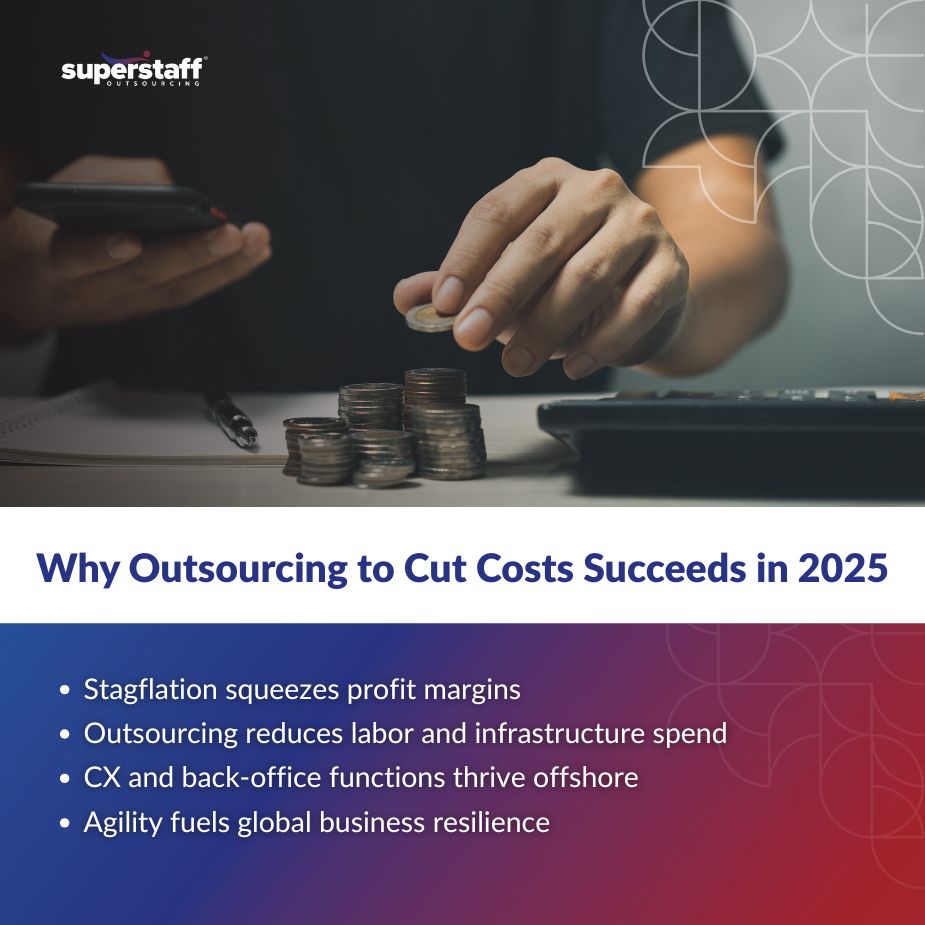
Stagflation may be back—and it’s putting pressure on margins and growth strategies.
As companies brace for economic stagnation paired with rising costs, traditional playbooks are failing. Layoffs, price hikes, and paused investments aren’t sustainable long-term moves. Leaders need smarter strategies—ones that solve today’s problems without creating tomorrow’s. That’s why many are embracing outsourcing to cut costs while continuing to scale strategically.
Smart companies aren’t standing still. They’re turning to outsourcing to cut costs, stay flexible, and keep scaling—despite the market squeeze.
This blog explores how outsourcing helps businesses thrive even in stagflationary environments, giving you a closer look at how global teams are helping companies do more with less.
Outsourcing Turns Stagflation Into a Strategic Advantage
When stagflation sets in, growth becomes more elusive. Operating expenses rise, customer demand slows, and investor expectations don’t ease. It’s a trap—but it’s one smart businesses are escaping by outsourcing to cut costs.
Instead of adding headcount domestically where wages are surging, companies tap into global talent pools. This reduces payroll expenses without compromising service quality. Labor arbitrage remains one of the most powerful benefits of outsourcing to cut costs—especially in 2025, where salary inflation is outpacing revenue growth in several sectors.
The flexibility of global teams also removes the need for large investments in physical infrastructure. Rather than lease new office space or invest in additional equipment, businesses leverage offshore providers who already have the setup. This significantly lowers capital expenditure, which is crucial during periods of slow or flat growth.
Outsourcing to cut costs isn’t just a numbers game. It’s a smarter approach to resource allocation when every dollar needs to stretch further. And in stagflationary climates, that efficiency often spells the difference between surviving and expanding.

Flexibility in a Foggy Economy: The Agility Outsourcing Delivers
Mixed economic signals can paralyze decision-making. Some forecasts call for recession, others for slow recovery. Markets fluctuate. In this chaos, agility becomes king. And few strategies deliver agility quite like outsourcing to cut costs while staying adaptable.
Long-term commitments like new leases or permanent hires feel risky in volatile conditions. With outsourcing, you gain the ability to scale teams up or down without the drag of traditional HR processes. Project-based outsourcing lets you ramp up support for seasonal campaigns or new launches, then pull back once the surge passes.
Remote-enabled teams add another layer of flexibility. Whether it’s BPO agents in the Philippines or tech specialists in Colombia, outsourced teams can keep operations running smoothly across time zones, holidays, and even during local disruptions. This ensures that operations remain stable—even when the rest of the market isn’t.
In the past, companies outsourced reactively. Today, the best companies outsource proactively. It’s not about reacting to crisis—it’s about positioning your business to stay nimble, efficient, and ready for anything. And that begins with outsourcing to cut costs and gain back control.
Why Scaling Is Faster With Outsourcing Than Traditional Hiring
When margins are tight, the idea of expanding might seem far-fetched. But the truth is, scaling smart doesn’t always mean scaling big—or expensive. It means finding fast, flexible paths to growth. And in 2025, that often means outsourcing to cut costs and gain scale without the usual friction.
Hiring full-time employees is a slow process. Recruitment timelines, onboarding delays, compliance considerations, and training periods all add up. It could take months before a new hire contributes meaningfully. Outsourcing bypasses those delays. Providers can deploy experienced teams in weeks—sometimes days—cutting the time between idea and execution dramatically.
This speed is a game-changer for growing businesses. Whether it’s launching a new product line, expanding to a new region, or handling a sudden spike in customer queries, outsourced support allows you to respond faster than your competitors.
And with lower risk. Instead of committing to full-time payroll or long-term contracts, companies test new strategies and markets with outsourced teams. That kind of optionality is invaluable during unpredictable economic phases—and it’s only possible when you’re outsourcing to cut costs and streamline growth.
Customer Experience Teams Are Leading the Outsourcing Charge
If there’s one area businesses can’t afford to neglect in stagflation, it’s customer experience. Retention becomes more valuable than acquisition, and customers grow more sensitive to service quality. This is where outsourcing to cut costs and enhance CX comes into play.
Outsourced customer service teams offer consistent, professional support—24/7—without the staffing challenges of managing internal teams. Especially during off-hours or holidays, having an offshore CX team ensures customers never feel neglected. This boosts satisfaction and loyalty, both of which are critical during slower growth cycles.
Beyond availability, quality also improves. Many outsourced teams specialize in resolving issues quickly, thanks to industry-specific training and established workflows. Bilingual and culturally fluent agents help brands expand their global footprint, offering seamless support in different regions.
During downturns, customer loyalty becomes your most valuable asset. Outsourcing to cut costs while improving customer interactions is one of the smartest moves a company can make. It builds resilience on the frontlines—right where your brand meets the world.
More Than CX: Outsourcing Back Office for Deeper Efficiency
Customer-facing roles aren’t the only ones benefiting from outsourcing. Back-office operations—from HR and finance to compliance and administration—are ripe for transformation. And companies are increasingly outsourcing to cut costs and refocus internal teams on higher-value work.
Accounting and payroll, for instance, can be easily outsourced to professionals in lower-cost regions, without compromising accuracy or compliance. Legal Process Outsourcing (LPO) and Knowledge Process Outsourcing (KPO) models are also growing in popularity, especially for businesses needing help with analytics, document processing, or contract management.
Outsourcing back-office tasks reduces the administrative burden on core teams. This frees up in-house staff to focus on strategic initiatives, innovation, and growth—critical priorities when margins are tight.
Compliance is another area where outsourcing shines. Regulations shift quickly, especially across international markets. Outsourced providers often have legal and operational experts who stay ahead of these changes, helping you stay compliant without expanding your internal legal team.
When leaders think about outsourcing to cut costs, they often think about CX. But the real savings—and strategic lift—can come from transforming what’s behind the scenes.
Outsourcing as a Long-Term Strategy, Not a Quick Fix
It’s tempting to view outsourcing as a temporary measure. But today’s top-performing companies are treating it as a core strategy for long-term resilience and innovation. Instead of outsourcing in response to crisis, they’re outsourcing to build enduring strength.
The pandemic taught us that continuity matters. Businesses that had outsourced support were able to maintain operations during shutdowns and transitions to remote work. Today, those same companies are using outsourcing to accelerate product development, support new customer segments, and explore untapped markets.
Outsourcing research and development functions allows companies to innovate without ballooning their in-house teams. From AI solutions to fintech compliance, outsourced partners are powering specialized functions once thought to require internal control.
This evolution speaks to the heart of the matter: outsourcing to cut costs is just the beginning. The real benefit lies in how outsourcing enables a more agile, tech-forward, and globally connected business model. And that’s what sets future-ready firms apart.
Why Outsourcing to Cut Costs Is the Stagflation Strategy That Works
In a stagflation-prone world, businesses can’t afford to play defense. Outsourcing empowers them to cut costs and scale forward.
From rising labor expenses to operational bottlenecks, the economy isn’t offering much slack. Yet, smart outsourcing strategies for 2025 are giving companies the leverage they need. Whether it’s responding faster to market shifts, accessing global talent, improving customer loyalty, or navigating regulatory hurdles—outsourcing delivers both savings and strategic lift.
Even with the stagflation impact on business outsourcing discussions, the consensus is growing: it’s not just a survival tactic. It’s how businesses scale with outsourcing in 2025 and beyond.
SuperStaff understands this shift. As a trusted outsourcing partner based in the Philippines, we help global companies unlock scalable growth, streamline costs, and build resilience—without compromise. Whether you’re scaling up your customer support, back-office ops, or specialized teams, we’ll build the right solution with you.
Let’s make your next move your smartest one. Reach out to SuperStaff today and discover how outsourcing to cut costs can drive long-term success.






